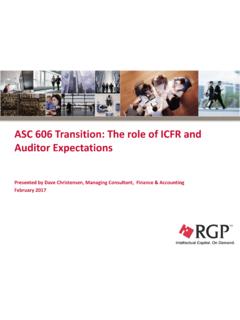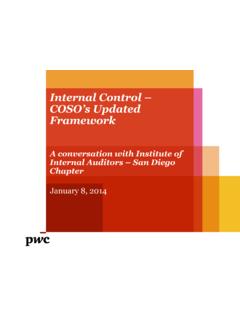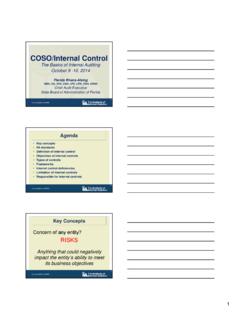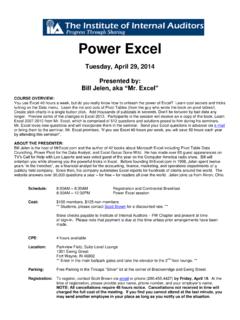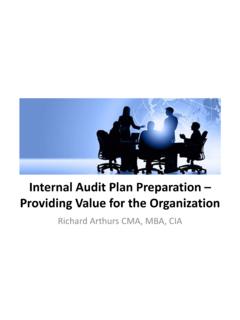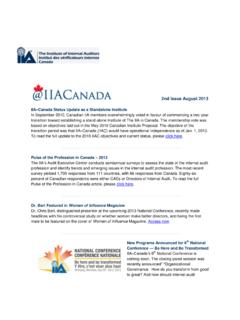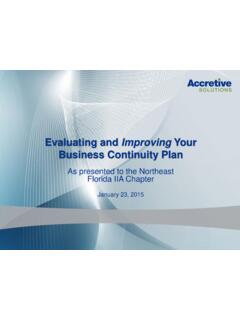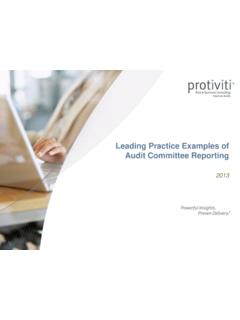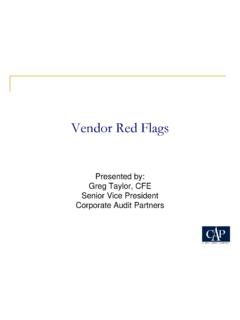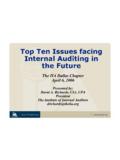Transcription of An Auditor’s Guide to Data Analytics - Chapters Site
1 data AnalyticsMay 11, 20131An Auditor s Guide to data AnalyticsNatasha DeKroon, Duke University Health SystemBrian Karp Experis, Risk Advisory ServicesData AnalyticsMay 11, 20132 Today s Agenda data Analytics the Basics Tools of the Trade Big data Continuous Auditing Case Study Benford s LawInternal Audit Focal PointsToolsPerspectiveData AnalyticsMay 11, 20133 data Analytics the BasicsData AnalyticsMay 11, 20134 What is data Analytics ? data Analytics is defined as the process of inspecting, cleaning, transforming, and modeling data with the goal of highlighting useful information, suggesting conclusions, and supporting decision sources data Analytics is an analytical process by which insights are extracted from operational, financial, and other forms of electronic data internal or external to the organization.
2 These insights can be historical, real-time, or predictive and can also be risk-focused ( , controls effectiveness, fraud, waste, abuse, policy/regulatory noncompliance) or performance focused ( , increased sales, decreased costs, improved profitability) and frequently provide the how? and why? answers to the initial what? questions frequently found in the information initially extracted from the AnalyticsMay 11, 20135 Not a New Concept Late 1980s generalized auditing software companies form ACL, 1987 Caseware, 1988 Charles Carslaw, Applying Benford s Law to Accounting, 1988 Continuous Process Auditing System, AT&T Bell Laboratories, 1989 data AnalyticsMay 11, 20136 Common data Types and data Structures data is generally organized into files or tables A table can be thought of as a two dimensional matrix of data Each row represents a single record Each column represents a data field Each data column, or field, may have a different data type data types determine how data is interpreted, and also what data format is considered valid For example, data can be a date.
3 A number, or plain text Invalid data in a table is often a sign of some other problem Often, each record in a table may have a unique identifier, like an employee, customer, or transaction ID When one table uses this identifier to reference records in another table, this is called a relational database Relational databases are a very useful way to organize data Many databases are built using some kind of relational database formatData AnalyticsMay 11, 20137 MethodologyPlanAcquire & UnderstandAnalyzeValidateReportData AnalyticsMay 11, 20138 data Analytics ToolsData AnalyticsMay 11, 20139 Desired Features in Analysis Tools Able to handle large data sets efficiently Wide array of analytical and statistical functions and procedures Programmability Logging of procedures performed on data Ability to easily re-run analysis with minor changesData AnalyticsMay 11, 201310 Types of Tools Spreadsheet software Databases Desktop software (Microsoft Access) Server-based (SQL/Oracle) Generalized auditing software ACL IDEA Other tools SAS SPSS Apache HadoopData AnalyticsMay 11, 201311 Generalized Auditing Software What is it?
4 Generalized auditing software ( , ACL and IDEA) tools are simple, powerful database tools with features designed for an auditor. Read only does not modify source data Audit log all commands are traceable and repeatable Scripting for automated or repetitive audits Powerful data connectivity can access almost any data , even text-based reports and flat filesData AnalyticsMay 11, 201312 Tools of the TradeData AnalyticsMay 11, 201313 Continuous AuditingData AnalyticsMay 11, 201314 Continuous Auditing Defined Continuous auditing is any method used by auditors to perform audit-related activities on a more continuous or continual basis. It is the continuum of activities ranging from continuous control assessment to continuous risk assessment all activities on the control-risk continuum.
5 -The IIA, GTAG 3: Continuous Auditing: Implications for Assurance, Monitoring, and Risk Assessment Continuous controls auditing using automated tools is one of the methods of continuous auditing Set frequency daily, weekly, monthly, AnalyticsMay 11, 201315 Case Study ACL CCM technology (now replaced by Audit Exchange) ACL as the implementation partner Six modules: GL, P2P, Payroll, T&E, PCard and O2C Multiple data sources (both in-house and third-party): SAP, ADP, Concur, American Express Mostly automated but some manual downloads of source data Focus on both master and transactional data Fraud detection, control deficiencies, data issuesData AnalyticsMay 11, 201316 Implementation Project Requirements and design specifications workshops with ACL, business process owners, IT and audit Build ACL Testing ACL and audit Training administrator and end user Go-live Continuous controls auditing programData AnalyticsMay 11, 201317 Examples of AnalyticsGeneral Ledger (24 tests) Critical data fields Unauthorized journal entry (JE) JEs by unauthorized users Duplicate JEs (same account/amount, same JE number/amount) Split JEs (single JE/multiple accounts, multiple JEs/single account)
6 Segregation of duties (park vs. post, post vs. create account) Dormant accounts Even dollar JEs Suspicious keyword in JE description Duplicate GL accounts based on the account descriptionData AnalyticsMay 11, 201318 Examples of AnalyticsPurchase to Pay (29 tests) Critical data fields (vendor master, requisition, purchase order (PO) Split requisitions and POs Stale requisitions and POs Segregation of duties (requisitioner vs. approver, purchaser vs. receiver, requisition approver vs. PO approver, purchaser vs. vendor master administrator, purchaser vs. AP clerk) PO date after invoice date Invoice number sequence Goods received quantity vs. invoice quantity Employee and vendor matches by name and by address Duplicate vendors (by name, address, bank account number) Duplicate purchases (same vendor same invoice number, same amount same GL account) data AnalyticsMay 11, 201319 Examples of AnalyticsPayroll (29 tests) Critical data fields (payroll master file) Duplicate employees (same bank account or address) Employee status not matching the termination date Exempt hours worked vs.)
7 Standard hours Non-exempt hours worked vs. expected hours Hours worked vs. hours paid Employee start date after paycheck date Terminations within 14 days of hire Invalid pay rates (actual/calculated vs. master file) Excessive gross pay 401k annual contribution limit, catch-up contribution limit and catch-up age limit Job record deletions ( data corrections not using effective date) data AnalyticsMay 11, 201320 Examples of AnalyticsTravel and Entertainment/Purchasing Card (30 + 32 tests) Critical data fields (cardholder master, expense, etc.) Invalid cardholder (no matching employee or terminated employee) Duplicate cardholders (by employee ID or address) Suspicious MCC Suspicious keyword in the transaction description Declined and disputed transactions Split purchases Duplicate purchases (same merchant same amount) New cardholder watch list/cardholder watch list Ghost card activities Even/small dollar amount transactions Weekend and holiday transactions Potential duplicate reimbursements: gas with mileage or PCard with an AP purchase Spending limits on transactions (lavish hotel stays, dinners, etc.)
8 data AnalyticsMay 11, 201321 Examples of AnalyticsOrder to Cash (46 tests) Critical data fields (customer master, sales order, etc.) Duplicate customers (on name or address) Credit limits vs. orders Segregation of duties (order entry vs. customer master, order entry vs. product master) Unauthorized/excessive commissions Delivery quantity vs. sales order quantity Shipment/sales order/price change by an unauthorized employee Cash receipt vs. invoice amount Shipment without a sales order Days sales outstandingData AnalyticsMay 11, 201322 Benefits and Costs/Risk Benefits Automation = saving time Trending of transactions Red flags Master data issues Control culture (you are being watched) SOX, FCPA and other regulatory requirements Costs/Risks Investment Time for review, follow-up and communication of results to management Insufficient understanding of source data (can result in many false positives) Lack of buy-in by managementData AnalyticsMay 11, 201323 Big DataData AnalyticsMay 11, 201324 Big DataWhat is Big data ?
9 Voluminous amounts of structured and unstructured data Structured currently identifiable by user; , database Unstructured does not fit easily into traditional relational systems; , email, word processing documents, multimedia, video, PDF files, spreadsheets, social media Defined in terms of petabytes and exabytes Ever more powerful information technology now allows consumers to carry gigabytes in their pockets and businesses to organize and analyze data on a scale never seen before. People s willingness to use the new electronic tools to communicate and share information about themselves means that even the most advanced companies are only scratching the surface of the behavioral patterns these troves of data can potentially reveal Source: The Financial Times data AnalyticsMay 11, 201325 Shift in data SourcesStructuredUnstructuredThe challenge is: Approximately 75-90% of data is unstructured (while IT is built for structured data ) Unstructured data is growing at nearly 10x the rate of structured data Less than 5% of unstructured data is proactively managedProductNameData TypeNullable?
10 PRODUCT_IDVARCHARNOCATEGORYVARCHARNOLIST _PRICEDECIMALNOData AnalyticsMay 11, 201326 The Four Vs of Big DataVolumeVolumeVelocityVelocityVarietyV arietyVeracityVeracityAmount of data generated or must be ingested, analyzed, and managed to enable business decisionsSpeed at which data is produced and changed; the speed at which data must be received, processed and understoodBoth structured and unstructured data generated by a wide range of sourcesThe quality and accuracy of received dataData AnalyticsMay 11, 201327A ZETABYTE IS ONE MILLION PETABYTES! data AnalyticsMay 11, 201328 Forces Impacting Utilization of Big DataTechnologyDataGovernance & PrivacyTalent & Skill SetsWhoWhatWhereHowScalabilityIntegratio nDeploymentAnalyticsTechnology Programming, Infrastructure, Cloud Computing, IntegrationData Generation Architecture, Modeling, ExtractionAnalyticsQuality vs.
